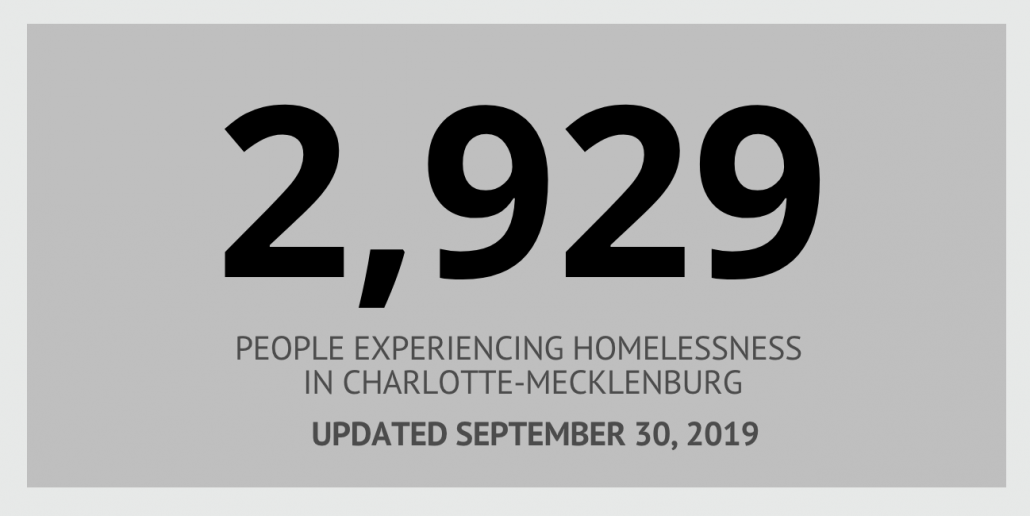Courtney Morton
Housing & Homelessness Research Coordinator
Mary Ann Priester
HMIS Administrator
Mecklenburg County Community Support Services (CSS) partners with homeless service agencies in Charlotte-Mecklenburg to enter, collect, analyze, and report data on housing and homelessness in the community. As part of this work, CSS released the Housing Data Snapshot in June 2019. The Housing Data Snapshot provides regular updates for the One Number, “By-Name” List, and Coordinated Entry.
This blog post highlights the latest changes and provides further analysis of the data added to the Housing Data Snapshot and what these changes mean for Charlotte-Mecklenburg.
ONE NUMBER
As of September 30, 2019, there are 2,929 individuals actively experiencing homelessness in Charlotte-Mecklenburg. This number includes 247 families (972 individuals within 247 households) and 1,969 single individuals. Of the 1,969 single individuals, 150 are unaccompanied youth (ages 18 – 24). The One Number, which is generated from the Homeless Management Information System (HMIS), was initially published in the September 2019 release of the State of Housing Instability & Homelessness in Charlotte-Mecklenburg Report.
Between June and September 2019, the One Number has increased by 39%, or 823 individuals. During the past thirty days, 319 people in families were added to the One Number by-name list.
One Number data may fluctuate for various reasons. These changes reflect both environmental and systemic conditions related to the access to and sustainability of affordable housing. Variations may also be due to data quality processes. An individual is removed from the One Number by-name list (which means they are no longer considered “actively homeless”) after 90 days of inactivity in HMIS. It is also important to remember that administrative data is not static; therefore, historical data is provided to view and track trends in One Number data overtime.
To access historical One Number data and trends, click this link.
CHRONIC HOMELESSNESS
In September 2019, there are 447 chronically homeless individuals who are still homeless in Mecklenburg County. This is the first recognized decrease in chronic homelessness in six months. Between August and September, there was an 6% decrease in chronic homelessness (30 individuals).
During the past quarter, the average inflow is 42 individuals, whereas the average outflow is 20. Unless the outflow increases, (which requires new housing options) and/or inflow decreases (as a result of increased housing stability), the number of chronically homeless individuals will continue to increase.
VETERAN HOMELESSNESS
In September 2019, there are 195 veterans who are still homeless in Mecklenburg County. This total is the lowest in the past six months. Between August and September, veteran homelessness decreased by 30%, or 85 individuals.
In September, the inflow was 20 compared with an outflow of 20, resulting in a net decrease of 2 individuals homeless. During the past quarter, the average inflow is 22 individuals, whereas the average outflow is 27. To continue this decrease in veteran homelessness, housing resources must be targeted to reduce inflow and increase outflow.
COORDINATED ENTRY
The Housing Data Snapshot has been updated with data for the first quarter. The data includes the number of 2-1-1 calls for housing assistance; the number of households referred for an in-person Coordinated Assessment; and the number of households who received an in-person Coordinated Assessment. In addition, a table is provided via this link to historical Coordinated Entry data.
The average number of monthly 2-1-1 calls between July and September 2019 is 599 and the average number of monthly in-person Coordinated Assessments is 412. While the average number of 2-1-1 calls during this quarter decreased by 18 calls, the number of in-person assessments increased by 85. It is important to note that while these numbers help illustrate the need for housing in the community, they do not encompass all of the households who face housing instability and homelessness and who do not seek assistance through the homeless services system.
SO, WHAT
In order to effectively address housing instability and homelessness, we must understand the problem more completely. Data provides us with one tool to do this. The data helps us understand the need of and demand for housing assistance.
When used effectively, these data points inform decision-making around housing and homelessness. Working groups dedicated to reducing inflow and increasing outflow among chronic and veteran homelessness, for example, meet regularly to brainstorm and test methods that can create positive change. It is critical that these groups continue to examine the inflow and outflow patterns in relationship to changes in programs and policies.
More housing is needed. As of the end of September, the total number of actively homeless veterans and chronically homeless individuals was 642; and the total number of all individuals was 2,929. In addition, the average inflow numbers into homelessness for both further illustrate the continued housing demand. The numbers are also an important tool to estimate annual housing need for planners and funders.
Courtney Morton coordinates posts on the Building Bridges Blog. Courtney is the Housing & Homelessness Research Coordinator for Mecklenburg County Community Support Services. Courtney’s job is to connect data on housing instability, homelessness and affordable housing with stakeholders in the community so that they can use it to drive policy-making, funding allocation and programmatic change.


